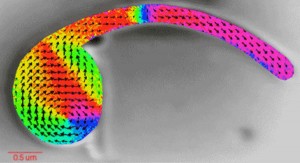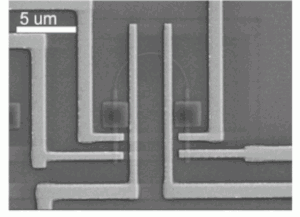Magnetic Domain Wall Memory and Logic Devices
- Category: Electronic Devices
- Tags: caroline ross, jean anne currivan, marc baldo
We are investigating the fabrication, material, and circuit properties of magnetic memory and logic devices. The research is divided into two main subjects. The first is the study of 360° domain walls (360 DWs), which show novel characteristics under DC and AC applied magnetic fields and currents and are a promising data token in racetrack memory applications. The second subject is designing and fabricating an instantiation of magnetic logic that has the potential to be more energy efficient than today’s transistors.
In 360 DWs, the magnetization makes a full in-plane 360° turn in a localized region of a magnetic wire, while the rest of the wire is magnetized parallel to its edges. Figure 1 shows a 360 DW in a Co nanowire [1] . Simulations [2] indicate that 360 DWs have a response to a current that is qualitatively different from the behavior of 180 DWs. The 360 DWs move at a velocity independent of applied magnetic fields and can be destroyed by a burst of applied current. The stability of the domain wall can be controlled by an externally applied field. These features make the 360 DW a data token candidate in novel domain wall logic and memory devices.
The heat dissipated per switching operation by logic transistors can potentially be greatly reduced by using a collective effect, such as the collective switching of magnetic moments. Thus, we are researching a device that uses the current-induced switching of a 180 DW in a soft ferromagnet to perform logic. The state of the logic gate is read out using a magnetic tunnel junction. Modeling of the device performance shows its potential for beyond-CMOS: it is nonvolatile, it is compatible with CMOS, it has a fanout greater than one, a single device acts as a universal NAND gate, and the power dissipation per device operation scales well with device size [3] . Figure 2 shows a device prototype, using NiFe as the soft ferromagnetic wire, with ends exchange biased with IrMn antiferromagnets to ensure a single 180 DW in the wire.
- Figure 1: SEMPA (scanning electron microscope with polarization analysis) image of a 360° domain wall in a 5- nm-thick Co wire attached to a circular injection pad.
- Figure 2: Device fabrication. A U-shape is used to fix the magnetization of the ends with one step. The tunnel junction for readback will be between the center contacts.
- Y. Jang, S. R. Bowden, M. Mascaro, J. Unguris, and C.A. Ross, “Formation and structure of 360 and 540 degree domain walls in thin magnetic stripes,” Appl. Phys. Lett., vol. 100, p. 062407, 2012. [↩]
- M. D. Mascaro and C. A. Ross, “AC and DC Current-Induced Motion of a 360˚ Domain Wall,” Phys. Rev. B vol. 82, p. 214411, 2010. [↩]
- J. A. Currivan, Y. Jang, M. D. Mascaro, M. A. Baldo, and C. A. Ross, “Low energy magnetic domain wall logic in short, narrow ferromagnetic wires, IEEE Magnetics Letters, vol. 3, p. 3000104, 2012. [↩]

